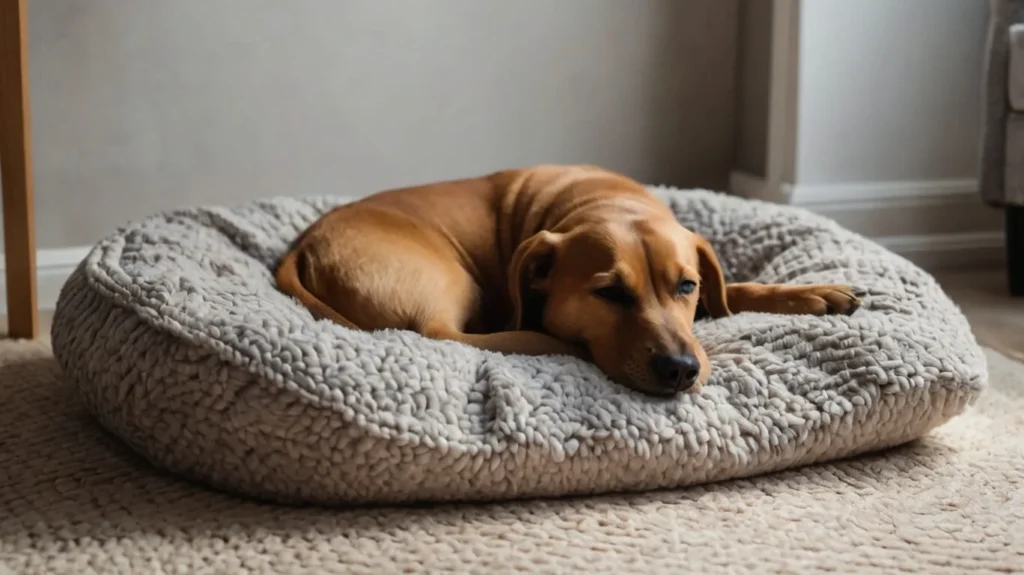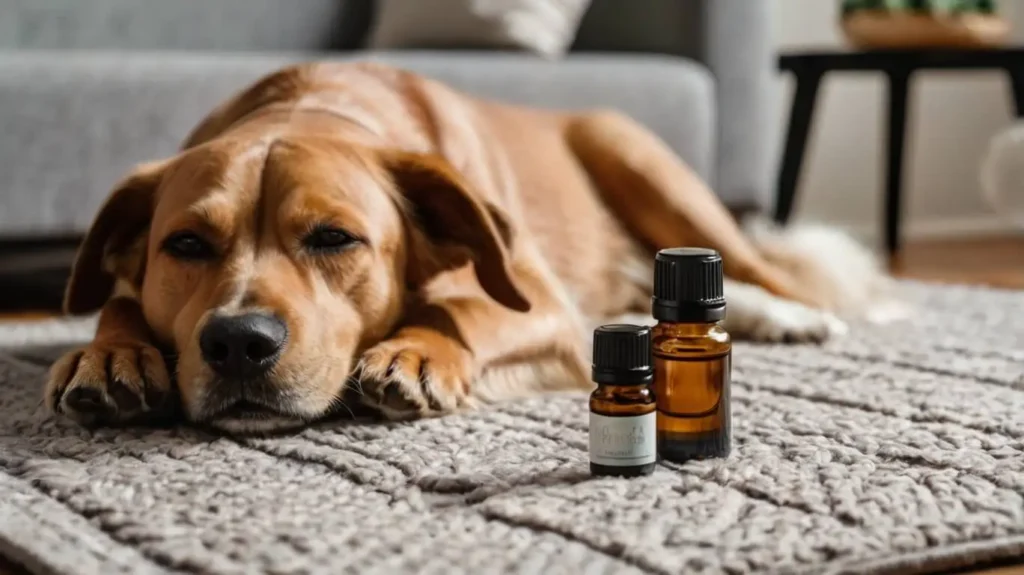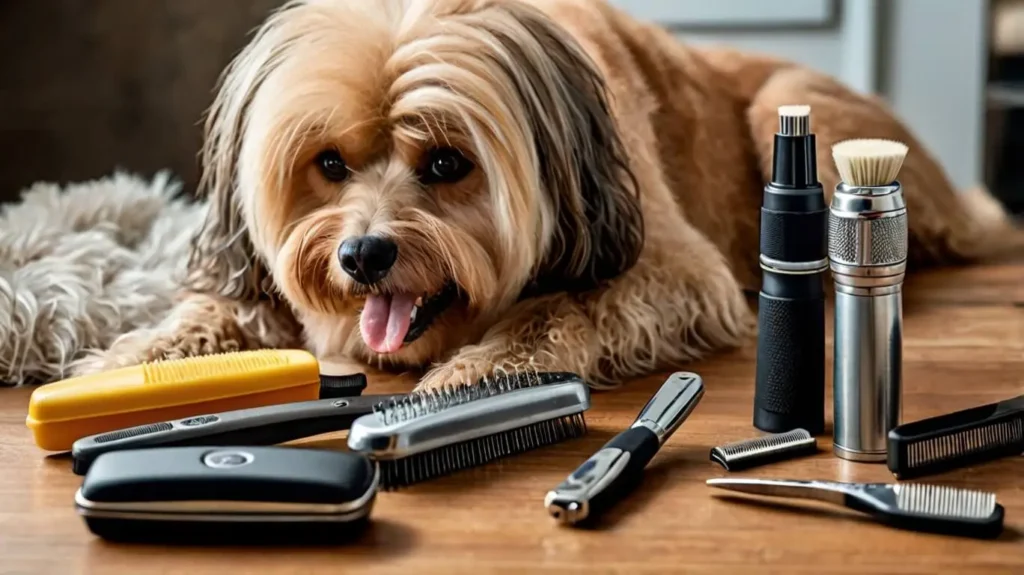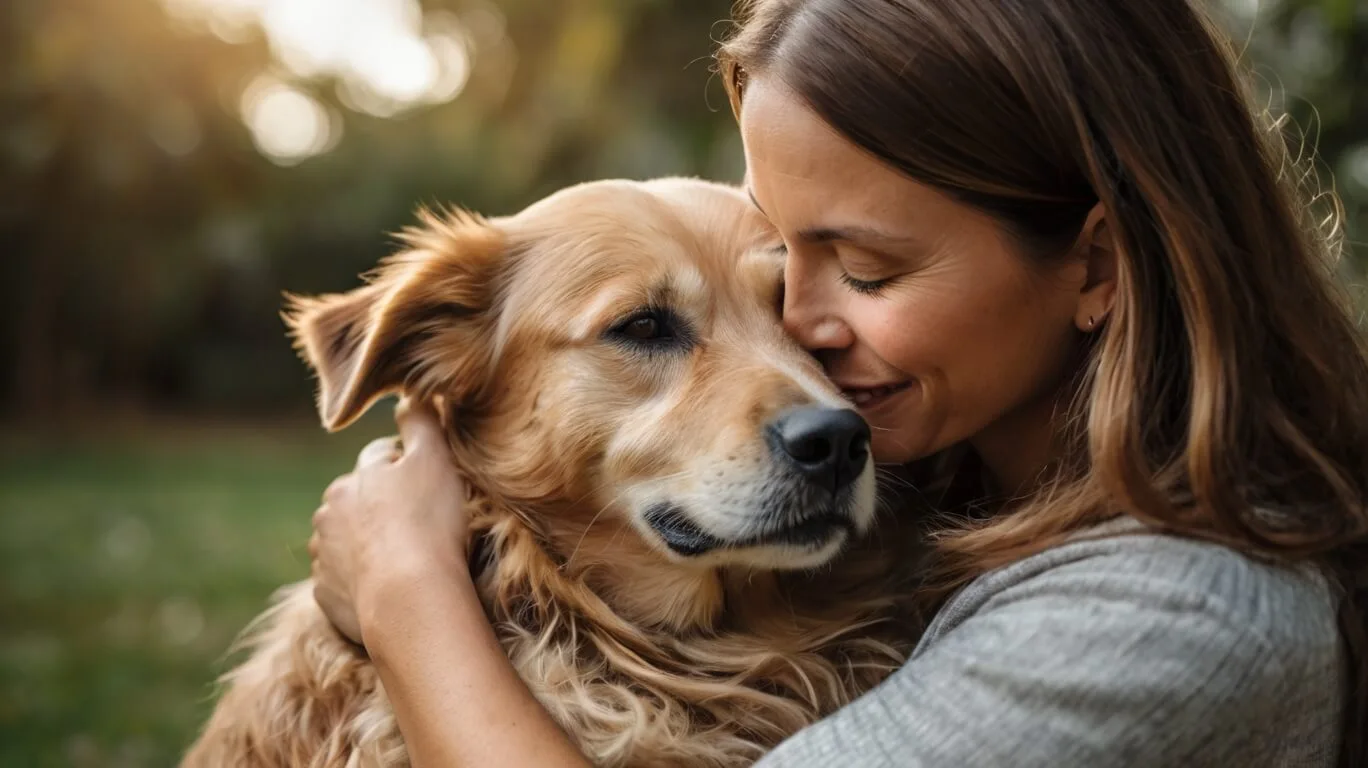The Ultimate Guide to Pampering Dogs at Home
Our dogs do so much for us — they offer loyalty, love, and endless tail wags. So why not return the favor with a little extra pampering? Pampering dogs isn’t just about spoiling them with treats (though they’d never complain!). It’s about creating a nurturing environment that supports their physical health, emotional well-being, and overall happiness.
Whether you’re looking to treat your pup to a spa day at home, offer calming comfort during stressful times, or simply add more joy to their routine, this guide is packed with easy, affordable, and thoughtful ways to make your dog feel truly loved. From soothing grooming rituals to fun enrichment toys and healthy homemade snacks, you’ll discover how to turn your home into a haven for your furry best friend.
Ready to give your dog the royal treatment? Let’s dive in.
Create a Relaxing Environment for Your Dog

Use Dog-Friendly Essential Oils
Essential oils can be a wonderful addition to your dog’s pampering routine — when used safely. Certain oils, like lavender, chamomile, and cedarwood, are known for their calming and soothing properties. These can help reduce anxiety, ease restlessness, and create a peaceful environment, especially helpful during thunderstorms, fireworks, or periods of separation.
✅ Safe Essential Oils for Dogs:
- Lavender – Known for its calming effects; ideal for relaxation and sleep.
- Chamomile – Gentle and soothing; can help reduce stress or skin irritations.
- Cedarwood – A natural deodorizer with grounding properties; also repels insects.
- Frankincense – Promotes emotional balance and may support immune health.
⚠️ Important Safety Tips:
- Always dilute essential oils with a carrier oil (like coconut or olive oil). A safe ratio is 1 drop of essential oil to 50 drops of carrier oil.
- Avoid applying oils directly to your dog’s skin or fur unless advised by a holistic veterinarian.
- Use a diffuser in a well-ventilated room, and make sure your dog has the option to leave the area if they’re uncomfortable.
- Never use toxic oils such as tea tree, eucalyptus, peppermint, citrus, or clove — these can be harmful or even fatal to dogs.
💡 Pro Tip:
Start with short sessions and observe how your dog reacts. If they seem more relaxed and content, you’ve likely found a winner. For extra pampering, try diffusing lavender oil during grooming, massage, or bedtime routines to help your pup fully unwind.
Set Up a Cozy Resting Space
Just like humans, dogs need a dedicated space where they can retreat, relax, and feel secure. A cozy resting area is a key part of pampering your dog at home — it supports their emotional well-being, helps manage stress, and encourages better sleep and behavior.
🛏️ Choose the Right Bed
Invest in a high-quality dog bed that suits your pup’s size, age, and health needs. For example:
- Orthopedic beds are ideal for senior dogs or breeds prone to joint issues.
- Bolster-style beds provide head and neck support, offering extra comfort.
- Cooling or heated beds can help regulate body temperature in extreme climates.
Place the bed in a quiet, low-traffic area of your home where your dog won’t be disturbed frequently.
🧸 Add Comfort Items
To enhance the space, consider including:
- Soft blankets or throws that your dog can burrow into.
- Plush toys or stuffed animals for comfort and companionship.
- A worn piece of your clothing (like an old T-shirt) with your scent to provide a sense of security when you’re away.
🌙 Make It Calming
- Use dim lighting or natural sunlight during the day to keep the space soothing.
- Consider adding a calming scent using a pet-safe diffuser nearby (e.g., diluted lavender).
- A white noise machine or soft background music can also help dogs who are easily startled or anxious.
💡 Pro Tip:
Keep the space clean and clutter-free. Wash bedding regularly to eliminate odors, allergens, and bacteria — your dog will appreciate the freshness just as much as the softness!
Try Soothing Music or White Noise
Sound can have a powerful effect on your dog’s mood and stress levels. Just like people, dogs are sensitive to their auditory environment — and using soothing music or white noise is a simple, effective way to pamper your pup and help them feel more at ease, especially in a home environment that might have unpredictable noises like traffic, loud neighbors, or sudden household sounds.
🎶 Calming Music for Dogs
Studies have shown that classical music, in particular, can reduce anxiety and lower heart rates in dogs. Soft instrumental tunes or ambient soundscapes can create a tranquil atmosphere and help:
- Calm dogs during thunderstorms or fireworks
- Reduce separation anxiety when you’re not home
- Encourage deeper rest or nap time
- Create a peaceful mood during grooming or spa routines
Some popular dog-calming playlists or apps to explore:
- Spotify’s “Calm Dogs” playlist
- YouTube channels like Relax My Dog
- Pet-specific apps like Pet Acoustics or DogTV
📻 The Benefits of White Noise
White noise machines (or apps) generate consistent ambient sounds like rainfall, a fan, or ocean waves. These help mask startling sounds and can prevent your dog from reacting to every little noise around the house.
White noise is especially helpful for:
- Dogs living in noisy urban environments
- Puppies adjusting to a new home
- Easily startled or anxious breeds (like Chihuahuas or Greyhounds)
- Dogs with noise sensitivity or a history of trauma
💡 Pro Tip:
Introduce music or white noise gradually. Start with low volume and watch your dog’s reaction. If they seem more relaxed — lying down, yawning, or even dozing off — you’ve found a winning sound. Make it part of their daily routine, especially during naps, bedtime, or alone time.
Use Calming Products
When it comes to pampering your dog, especially one prone to stress or anxiety, calming products can make a big difference. These tools and supplements are designed to support your dog’s emotional well-being and help them feel secure, especially in potentially stressful situations like thunderstorms, car rides, vet visits, or when left home alone.
🧥 Anxiety Wraps & Calming Vests
One of the most popular options is the ThunderShirt — a snug, vest-like garment that applies gentle, constant pressure to your dog’s torso. This sensation can have a calming effect, much like swaddling an infant. Anxiety wraps are great for:
- Separation anxiety
- Loud noises (e.g., fireworks, storms)
- Travel or unfamiliar environments
🍬 Calming Chews & Treats
There are many natural supplemental treats designed to promote calmness using ingredients like:
- L-theanine and L-tryptophan – amino acids known to reduce anxiety
- Chamomile and valerian root – herbal relaxants
- CBD (hemp-based, pet-safe) – offers relief from anxiety and inflammation
Look for veterinarian-approved products that are free from artificial fillers, and always follow dosage guidelines.
💧 Calming Sprays & Diffusers
Pheromone sprays and diffusers, such as those by Adaptil®, mimic the natural calming pheromones a mother dog emits to her puppies. These are ideal for:
- Reducing general anxiety
- Helping with crate training
- Creating a calm environment in rooms or cars
You can also find herbal sprays made with lavender, chamomile, or geranium — just make sure they are specifically formulated for dogs and free of alcohol or toxins.
🐾 Comfort Items
Sometimes, the simplest items offer the most comfort:
- Weighted blankets for dogs (for deep pressure stimulation)
- Snuggle toys with heartbeat simulators (great for puppies or rescue dogs)
- Cooling or heating pads for dogs with muscle tension or joint stiffness
💡 Pro Tip:
Not every product works for every dog. Start with one or two options, introduce them gradually, and monitor how your dog responds. If your pup seems visibly calmer — resting more, whining less, or pacing less frequently — you’ve found a great addition to their pampering routine.
Pamper Your Dog with At-Home Spa Treatments
Brush and De-shed with the Right Tools
Regular brushing is one of the simplest yet most effective ways to pamper your dog. Not only does it keep their coat clean and shiny, but it also improves circulation, distributes natural oils, reduces shedding, and provides a wonderful opportunity for bonding. Plus, most dogs love the soothing sensation — when done gently and with the right tools.
🧼 Why Brushing Matters
- Removes loose hair and prevents matting, especially in long-haired breeds.
- Stimulates the skin and helps distribute healthy oils through the coat.
- Reduces allergens and dander in the home, which is especially helpful for allergy sufferers.
- Keeps your dog comfortable, especially during seasonal coat changes.
🪮 Choosing the Right Grooming Tools
Every coat type requires a different brush. Here’s a quick breakdown:
- Slicker Brush:
Ideal for medium to long-haired dogs like Golden Retrievers, Collies, or Poodles. It helps remove tangles, mats, and loose fur while smoothing the coat. - De-shedding Tool (like the FURminator®):
Great for double-coated breeds like Huskies, Labs, and German Shepherds. It reaches the undercoat to reduce seasonal shedding by up to 90%. - Bristle Brush:
Perfect for short-haired dogs like Beagles or Boxers. It removes dirt and adds shine without irritating the skin. - Pin Brush:
Good for curly or woolly coats (like Doodles or Poodles). It gently detangles and fluffs the coat without pulling. - Rubber Grooming Mitts:
Ideal for dogs who are nervous around traditional brushes. These gloves offer a gentle massage while removing loose fur — great for bath time or sensitive pups.
🐶 How Often Should You Brush?
- Long-haired dogs: Daily or every other day to prevent mats.
- Short-haired dogs: 1–2 times per week.
- Heavy shedders: 3–4 times per week during shedding season.
💡 Pro Tip:
Make brushing a positive experience. Use treats, a calm voice, and gentle strokes. Always check for signs of irritation, hot spots, or parasites while grooming — it’s the perfect time for a mini health check!

DIY Bath Time with Natural Products
Bathing your dog at home is a fantastic way to pamper them while ensuring they stay clean, healthy, and comfortable. Using natural products not only protects your dog’s sensitive skin but also avoids harsh chemicals that can cause irritation, dryness, or allergic reactions. Plus, a soothing bath can be a bonding ritual that your dog looks forward to!
🛁 Preparing for Bath Time
Before you start, gather everything you need: a dog-friendly shampoo, a non-slip mat, towels, and maybe some treats to reward good behavior. Choose a location that’s comfortable for your dog — whether it’s a bathtub, a large sink, or even outdoors on a warm day.
🌿 Choosing the Right Natural Shampoo
Look for shampoos that are:
- Free of parabens, sulfates, and artificial fragrances
- Made with gentle, plant-based ingredients like oatmeal, aloe vera, coconut oil, or chamomile
- Hypoallergenic if your dog has sensitive skin or allergies
Oatmeal shampoos are especially popular because they soothe itchy, dry skin, while aloe vera provides moisture and healing properties. Coconut oil-based shampoos can naturally repel fleas and add shine to the coat.
💧 How to Bathe Your Dog Properly
- Brush your dog first to remove tangles and loose fur.
- Use lukewarm water — too hot or cold can be uncomfortable or stressful.
- Wet your dog thoroughly, avoiding the eyes and inside the ears.
- Apply shampoo gently, working it into a lather and massaging the skin — this also helps stimulate blood circulation.
- Let the shampoo sit for a few minutes if it contains soothing ingredients like oatmeal or aloe.
- Rinse thoroughly to ensure no residue remains, which can irritate the skin.
- Towel dry your dog and, if they tolerate it, finish with a gentle blow-dry on a low setting.
🍋 Optional Natural Add-ons
- Apple Cider Vinegar Rinse (diluted with water): Can help with odor control and soothe irritated skin.
- Coconut Oil Treatment: Applied after drying, it moisturizes and gives the coat a glossy finish.
- Herbal Bath Soaks: Chamomile or calendula tea used as a final rinse to calm the skin.
💡 Pro Tip:
Make bath time a positive, stress-free experience by talking to your dog in a soothing voice, offering treats, and keeping sessions short but thorough. Overbathing can dry out skin, so aim for once a month or as recommended by your vet based on your dog’s coat and activity level.
Paw Care and Nail Trimming
Taking care of your dog’s paws and nails is an essential part of their grooming routine and a wonderful way to pamper them. Healthy paws allow your dog to walk, run, and play comfortably, while well-maintained nails prevent pain and injuries. Plus, regular paw care can help you spot issues early, like cuts, infections, or irritations.
🐾 Why Paw Care Matters
Dogs use their paws for everything—exploring, digging, and balancing. Their paw pads are tough but sensitive and can get cracked, dry, or injured from rough terrain, hot pavement, ice, or allergens. Regular care keeps paws soft, healthy, and protected.
✂️ Nail Trimming Basics
Long nails can cause discomfort, affect your dog’s gait, and even lead to joint problems. Trimming nails regularly:
- Prevents nails from snagging or breaking
- Reduces the risk of painful splits or infections
- Helps your dog maintain proper posture and balance
🛠️ Tools You’ll Need
- Dog nail clippers (guillotine or scissor-style) — choose based on what you find easier to handle
- Nail grinder (Dremel tool) — smooths edges and reduces the risk of nail splitting
- Styptic powder or pencil — essential to stop bleeding if you accidentally cut the quick (the sensitive part inside the nail)
- Paw balm or moisturizer — to soothe and protect paw pads
🐕 Step-by-Step Nail Trimming Tips
- Choose a calm time when your dog is relaxed.
- Gently hold your dog’s paw and inspect the nails for the quick (pink area visible in light-colored nails). Avoid cutting into this sensitive part.
- Trim small amounts off the nail tip at a time.
- Use a nail grinder to smooth rough or sharp edges after clipping.
- Praise and reward your dog throughout to create a positive experience.
🧴 Caring for Your Dog’s Paws
- Check paws regularly for cuts, cracks, foreign objects, or irritation.
- Clean paws after walks, especially if they’ve been on salted roads, muddy trails, or sandy beaches.
- Apply a paw balm (made from natural ingredients like shea butter or beeswax) to moisturize and protect pads, especially in extreme weather conditions.
💡 Pro Tip:
If you’re nervous about trimming nails, start by getting your dog comfortable with paw handling. Touch and massage their paws daily and offer treats to build trust. For dogs with dark nails where the quick isn’t visible, trim very small bits and take breaks to avoid cutting too far.
Try a Gentle Dog Massage
Pampering your dog with a gentle massage isn’t just a luxury—it’s a wonderful way to promote relaxation, improve circulation, ease muscle tension, and strengthen your bond. Massage therapy can help calm anxious dogs, support older pets with joint stiffness, and enhance overall well-being.
🤲 Benefits of Dog Massage
- Relieves stress and anxiety by releasing feel-good hormones like serotonin and oxytocin.
- Improves blood circulation and lymphatic drainage, supporting the immune system.
- Eases muscle soreness, stiffness, and joint pain, especially in senior dogs or those recovering from injury.
- Promotes better sleep and relaxation.
- Strengthens the connection between you and your dog through gentle, mindful touch.
🐕 How to Give a Gentle Massage
- Choose a quiet, comfortable spot where your dog feels safe.
- Start by softly petting your dog to help them relax.
- Use slow, gentle strokes with your fingertips or the palm of your hand, focusing on areas like:
- Neck and shoulders
- Back and spine (avoiding the bones themselves)
- Chest and ribcage
- Legs and paws (be gentle around joints)
- Pay attention to your dog’s body language — if they lean in or close their eyes, they’re enjoying it; if they pull away or tense up, adjust your pressure or location.
- Incorporate light circular motions, gentle kneading, or long strokes to soothe muscles.
- Keep sessions short initially (5–10 minutes) and gradually extend if your dog responds positively.
💡 Massage Techniques to Try
- Effleurage: Long, gliding strokes to warm up muscles.
- Petrissage: Gentle kneading to relax muscles and increase circulation.
- Circular motions: Use your fingertips in small circles on tense spots.
- Light tapping: Rhythmic, gentle tapping to stimulate nerve endings.
🧴 Optional Enhancements
- Use a few drops of dog-safe essential oils diluted in a carrier oil (like coconut oil) to enhance relaxation — lavender or chamomile are good choices.
- Play soft, calming music in the background for a full spa vibe.
💡 Pro Tip:
If your dog has any medical conditions, consult your vet before starting massage therapy. With regular practice, massage can become a favorite pampering ritual that helps keep your dog happy and healthy.
Offer Healthy Homemade Dog Treats
Bake Simple Treats with Natural Ingredients
Nothing says pampering quite like homemade treats made with love and wholesome, natural ingredients. Baking your own dog treats lets you control exactly what goes into them — avoiding preservatives, artificial flavors, and unhealthy fillers common in store-bought snacks. Plus, dogs love the special attention, and you’ll enjoy the satisfaction of making something healthy and delicious for your furry friend.
🍪 Benefits of Homemade Dog Treats
- Control over ingredients — perfect for dogs with allergies or dietary restrictions.
- Freshness and quality — no artificial preservatives or additives.
- Customizable flavors and textures to suit your dog’s preferences.
- Bonding time — baking treats can become a fun ritual you share with your dog.
🥕 Healthy Ingredients to Use
Focus on simple, nutritious ingredients that are safe for dogs, such as:
- Whole wheat or oat flour (gluten-free flours like rice or chickpea flour work for sensitive pups)
- Pumpkin puree — rich in fiber and great for digestion
- Peanut butter (make sure it’s xylitol-free!) — packed with healthy fats and protein
- Applesauce or mashed bananas — natural sweetness without added sugar
- Eggs — a great source of protein and binding agent
- Carrots, sweet potatoes, blueberries — packed with vitamins and antioxidants
- Plain yogurt or cottage cheese — for a creamy texture and probiotics
🧁 Simple Dog Treat Recipes to Try
- Pumpkin Peanut Butter Biscuits
Mix 1 cup pumpkin puree, 1/2 cup peanut butter, 2 cups whole wheat flour, and 1 egg. Roll out dough, cut into shapes, and bake at 350°F (175°C) for 20–25 minutes. - Banana Oat Cookies
Combine 1 mashed banana, 1 cup oats, and 1/4 cup unsweetened applesauce. Form small cookies and bake at 325°F (165°C) for 15–20 minutes. - Sweet Potato Chews
Slice sweet potatoes into thin strips and bake at 250°F (120°C) for 2–3 hours until chewy.
🥄 Baking Tips
- Avoid harmful ingredients like chocolate, grapes, raisins, onions, garlic, and xylitol (a sweetener toxic to dogs).
- Store treats in an airtight container or freeze for longer freshness.
- Always introduce new treats gradually to monitor for any food sensitivities.
💡 Pro Tip:
Get your dog involved by letting them “help” in the kitchen — whether it’s sniffing ingredients or waiting patiently for their first bite. Homemade treats are a delicious, healthy way to say “I love you” with every bite.
Use a Dog Treat Maker or Silicone Molds
Baking homemade treats for your dog is not only a thoughtful way to pamper them but also a fun and creative activity for you! Using a dog treat maker or silicone molds can simplify the process, making it easy to create perfectly shaped, consistent treats that your dog will love.
🧁 What Is a Dog Treat Maker?
A dog treat maker is a kitchen appliance designed specifically for making healthy dog treats at home. These devices often function like mini ovens or dehydrators, allowing you to bake or dry treats with minimal effort. They can speed up the process and help produce treats with the perfect texture—whether crunchy biscuits or chewy snacks.
🧩 Benefits of Using Silicone Molds
Silicone molds come in a variety of fun shapes and sizes — bones, paws, hearts, and more — letting you personalize your treats and make the experience even more enjoyable. They are:
- Non-stick and easy to clean, so your treats come out perfectly every time.
- Flexible and durable, making it simple to pop out treats without breaking them.
- Safe for use in ovens and freezers, allowing for baked or frozen treats.
- Great for portion control, ensuring treats are the right size for your dog.
🍪 How to Use Silicone Molds for Dog Treats
- Prepare your favorite homemade dog treat batter or dough.
- Lightly grease the molds with a little coconut oil or use a non-stick spray to make removal easier.
- Spoon the batter evenly into each mold cavity, smoothing the tops with a spatula.
- Bake or freeze according to your recipe’s instructions.
- Allow treats to cool completely before removing them from the molds.
🥶 Beyond Baking: Frozen Treats
Silicone molds are perfect for making frozen dog treats during hot months. Simply fill the molds with dog-safe ingredients like plain yogurt, mashed fruit, or broth, and freeze until solid. These cool treats help keep your dog refreshed and hydrated.
💡 Pro Tip:
Invest in a set of various-sized molds so you can make treats suitable for small or large dogs. Using molds also makes it easy to portion treats for training sessions or special rewards without overfeeding.
Rotate Flavors to Avoid Boredom
Just like humans, dogs can get bored with eating the same treats repeatedly. To keep your pup excited and engaged during treat time, it’s important to rotate flavors and ingredients regularly. This simple strategy not only keeps snack time fun but also provides a wider range of nutrients to support your dog’s overall health.
🍖 Why Rotate Flavors?
- Prevents picky eating habits: Dogs may refuse treats if they get tired of the same flavor or texture.
- Promotes balanced nutrition: Different ingredients bring different vitamins, minerals, and antioxidants.
- Keeps treats interesting: Variety adds excitement and keeps your dog motivated, especially during training or special rewards.
- Helps identify sensitivities: Rotating ingredients can help you spot any food intolerances or allergies.
🥕 How to Rotate Flavors Effectively
- Plan a rotation schedule: Change your dog’s treat flavor every week or every few days depending on how often you give treats.
- Use a variety of proteins: Alternate between chicken, beef, salmon, turkey, or lamb-based recipes.
- Incorporate different fruits and veggies: Mix in pumpkin, sweet potatoes, carrots, blueberries, or apples for natural sweetness and nutrients.
- Experiment with textures: Offer crunchy biscuits, soft chews, or frozen treats to keep things interesting.
- Introduce seasonal flavors: Use seasonal ingredients like pumpkin in fall or watermelon in summer for a fun twist.
🌿 Sample Flavor Rotation Ideas
- Monday: Peanut butter and pumpkin biscuits
- Wednesday: Sweet potato chews
- Friday: Apple and cinnamon soft treats
- Sunday: Frozen yogurt and blueberry pops
💡 Pro Tip:
Keep a treat journal to track what flavors your dog enjoys most and note any reactions or preferences. This will help you tailor your homemade treat recipes perfectly to your pup’s tastes and needs.
Avoid Harmful Ingredients
When pampering your dog with homemade treats, it’s crucial to ensure that all ingredients are safe and healthy for canine consumption. Many common human foods can be toxic or harmful to dogs, even in small amounts. Avoiding these dangerous ingredients will keep your furry friend safe and happy while you spoil them with delicious snacks.
⚠️ Common Ingredients to Avoid
- Chocolate: Contains theobromine and caffeine, which are toxic to dogs and can cause vomiting, diarrhea, rapid breathing, seizures, or even death.
- Grapes and Raisins: Even small amounts can lead to kidney failure in dogs.
- Onions and Garlic: These can damage your dog’s red blood cells, leading to anemia.
- Xylitol: A sugar substitute found in sugar-free gums, candies, and some peanut butters — extremely toxic and can cause rapid insulin release, resulting in hypoglycemia or liver failure.
- Macadamia Nuts: Can cause weakness, tremors, and overheating in dogs.
- Alcohol: Even tiny amounts can be fatal, affecting the nervous system and liver.
- Caffeinated Beverages or Ingredients: Like coffee, tea, or energy drinks, these can overstimulate your dog’s heart and nervous system.
- Raw Dough with Yeast: Can expand in the stomach, causing pain and potentially dangerous complications.
🥄 Ingredients That Need Caution or Moderation
- Salt: Excessive salt can lead to dehydration and sodium ion poisoning.
- Fatty Foods: Can cause pancreatitis, a painful inflammation of the pancreas.
- Dairy Products: Some dogs are lactose intolerant and may experience digestive upset.
- Bones: Cooked bones can splinter and cause choking or internal damage.
🧑🍳 Tips for Safe Homemade Treats
- Always read labels carefully on store-bought ingredients like peanut butter or broth to ensure they don’t contain harmful additives.
- Stick to simple, whole foods that are known to be safe for dogs.
- When introducing a new ingredient, give it in small amounts to watch for any adverse reactions.
- Consult your veterinarian if your dog has special dietary needs, allergies, or health conditions.
💡 Pro Tip:
If you’re ever unsure whether an ingredient is safe, it’s best to leave it out or double-check with your vet or reputable pet nutrition sources. Safety always comes first when pampering your dog with homemade goodies!

Enrich Their Day with Interactive Toys and Games
Puzzle Toys for Mental Stimulation
Keeping your dog mentally stimulated is just as important as physical exercise when it comes to their overall happiness and well-being. Puzzle toys are an excellent way to challenge your dog’s brain, prevent boredom, and reduce anxiety or destructive behaviors. These interactive toys engage your dog in problem-solving and reward them with treats, making playtime both fun and mentally enriching.
🧩 What Are Puzzle Toys?
Puzzle toys come in various designs, from simple treat-dispensing balls to complex interactive boards with hidden compartments. The goal is to encourage your dog to figure out how to access a hidden reward, such as kibble or a favorite treat, by using their paws, nose, or mouth.
🐕 Benefits of Puzzle Toys
- Enhances cognitive skills: Encourages dogs to think, strategize, and learn new skills.
- Reduces boredom: Keeps your dog occupied and less likely to engage in destructive behaviors.
- Slows down eating: Great for dogs who eat too quickly, promoting better digestion and weight control.
- Boosts confidence: Successfully solving puzzles builds your dog’s confidence and reduces stress.
- Strengthens the bond: Interactive play sessions foster a deeper connection between you and your dog.
🧸 Popular Types of Puzzle Toys
- Treat-Dispensing Balls: Your dog rolls or manipulates the ball to release treats gradually.
- Interactive Puzzle Boards: Feature sliding pieces, flip covers, or rotating compartments that challenge your dog to unlock treats.
- Snuffle Mats: Mimic foraging by hiding treats within fabric strips for your dog to sniff out.
- Hide-and-Seek Toys: Toys with hidden compartments or layers that your dog must explore to find rewards.
🐶 How to Introduce Puzzle Toys
- Start with simpler puzzles to avoid frustration.
- Supervise your dog during the first few sessions to guide and encourage them.
- Gradually increase the difficulty as your dog becomes more skilled.
- Use high-value treats to keep your dog motivated.
- Incorporate puzzle toys into daily playtime or feeding routines.
💡 Pro Tip:
Rotate different puzzle toys regularly to maintain your dog’s interest and challenge their problem-solving abilities. Mental exercise with puzzle toys complements physical activity, keeping your dog balanced and content.
Chew Toys for Relaxation and Dental Health
Chew toys are an essential part of any dog’s playtime, providing both relaxation and important dental benefits. Dogs have a natural instinct to chew, which helps them relieve stress, expend energy, and maintain strong, healthy teeth and gums. Offering your dog the right chew toys is a simple yet effective way to pamper them while promoting good oral hygiene.
🦷 Why Chew Toys Matter
- Relieve stress and anxiety: Chewing can be a calming activity that helps reduce nervous energy and boredom.
- Promote dental health: Chew toys help scrape away plaque and tartar buildup, reducing the risk of gum disease and bad breath.
- Prevent destructive chewing: Providing appropriate chew toys satisfies your dog’s urge to chew and protects your belongings.
- Encourage healthy jaw muscles: Chewing strengthens the jaw and keeps teeth properly aligned.
🧸 Types of Chew Toys
- Rubber Chew Toys: Durable and flexible, great for strong chewers. Brands like Kong offer toys that can be stuffed with treats for added fun.
- Nylon Bones: Harder chew toys designed for aggressive chewers that help clean teeth effectively.
- Edible Chews: Natural options like bully sticks or dental chews that promote chewing and freshen breath.
- Rope Toys: Help clean teeth by flossing and also satisfy your dog’s chewing instinct.
🐕 Choosing the Right Chew Toy
- Select chew toys appropriate for your dog’s size, age, and chewing strength.
- Avoid toys that are too small to prevent choking hazards.
- Inspect toys regularly and replace them if they become worn or broken.
💡 How to Use Chew Toys for Maximum Benefit
- Rotate chew toys to keep your dog interested and engaged.
- Use chew toys during times when your dog feels anxious or needs to relax, such as during thunderstorms or when alone.
- Combine chew toys with training rewards for positive reinforcement.
🦷 Dental Care Tip:
Pair chew toys with regular tooth brushing and annual vet dental check-ups for the best oral health.
Tug and Fetch Toys for Active Play
Active play is essential for keeping your dog physically fit, mentally sharp, and emotionally happy. Tug and fetch toys provide dynamic ways to engage your dog’s energy while strengthening your bond through interactive play. These toys encourage exercise, stimulate natural instincts, and offer a fun outlet for your dog’s playful spirit.
🎾 Why Tug and Fetch Toys Are Great
- Promote physical exercise: Running, jumping, and tugging keep muscles strong and improve cardiovascular health.
- Enhance mental stimulation: Fetch and tug games require focus, timing, and strategy.
- Strengthen your bond: Playtime builds trust and deepens your connection with your dog.
- Channel natural behaviors: Tugging satisfies instinctive behaviors, while fetch taps into your dog’s retrieving skills.
- Provide a healthy outlet: Helps reduce boredom and prevent destructive behavior from excess energy.
🦴 Popular Tug and Fetch Toys
- Rope Tug Toys: Durable and great for interactive tug-of-war games. They’re also good for dental health by gently flossing teeth.
- Rubber Balls: Sturdy balls designed to bounce and float, perfect for outdoor fetch.
- Frisbees: Lightweight and flexible discs that dogs love to chase and catch mid-air.
- Squeaky Tug Toys: Combine the fun of tugging with the excitement of a squeak, keeping your dog engaged longer.
🐕 Tips for Safe and Fun Tug and Fetch Play
- Use toys made from safe, non-toxic materials that can withstand your dog’s bite.
- Teach your dog a reliable “drop it” or “release” command to keep play safe and controlled.
- Avoid overly aggressive tugging to prevent injury to your dog’s teeth or jaw.
- Play in open, safe areas free of hazards.
- End play sessions on a positive note to keep your dog enthusiastic for next time.
💡 Pro Tip:
Incorporate fetch and tug games into your dog’s daily routine for a balanced mix of physical and mental activity. These games are excellent for all ages and sizes, just tailor the toy and intensity to your dog’s abilities.
Snuffle Mats and Treat Dispensers
Engaging your dog’s natural foraging instincts is a fantastic way to keep their mind sharp and provide enriching playtime. Snuffle mats and treat dispensers are excellent tools that encourage your dog to work for their food or treats, providing both mental stimulation and slow feeding benefits. These toys can help alleviate boredom, reduce anxiety, and promote healthy eating habits.
🌿 What Are Snuffle Mats?
A snuffle mat is a textured mat made from layers of fabric strips or fleece tied onto a base. Treats or kibble are hidden within the folds and crevices, encouraging your dog to use their nose and paws to forage and “hunt” for their food. This activity taps into your dog’s natural sniffing and searching behaviors, which are mentally rewarding and calming.
🧸 What Are Treat Dispensers?
Treat dispensers come in many shapes and sizes — from balls with small holes to complex puzzle containers. Your dog has to manipulate the toy by rolling, pawing, or nudging it to release treats gradually. These toys combine fun with challenge, keeping your dog busy and entertained.
🐕 Benefits of Snuffle Mats and Treat Dispensers
- Mental stimulation: Forces dogs to think and problem-solve to access treats.
- Slow feeding: Helps prevent gulping and promotes better digestion.
- Stress relief: Foraging is a natural calming activity that reduces anxiety.
- Prevents boredom: Keeps dogs engaged during times when you’re busy or away.
- Weight management: By making treats harder to access, it slows consumption and helps control portions.
🎯 Tips for Using Snuffle Mats and Treat Dispensers
- Start with easy hiding spots or treat dispenser settings to build confidence.
- Use high-value treats or your dog’s regular kibble to motivate and reward.
- Supervise your dog initially to ensure they use the toy correctly.
- Regularly clean snuffle mats and dispensers to maintain hygiene.
- Rotate these toys with others to keep playtime fresh and exciting.
💡 Pro Tip:
Combine snuffle mats and treat dispensers with training sessions or quiet downtime to enrich your dog’s environment and promote calm behavior. They are perfect for dogs of all ages and energy levels.
Strengthen Your Bond Through Quality Time
Daily Walks and Outdoor Adventures
One of the simplest yet most effective ways to pamper your dog is by ensuring they get regular daily walks and outdoor adventures. These outings not only provide essential physical exercise but also offer invaluable mental stimulation, socialization opportunities, and a chance to explore the world from your dog’s perspective. Whether it’s a quick neighborhood stroll or an exciting hike in nature, time spent outdoors enriches your dog’s life in countless ways.
🐾 Why Daily Walks Matter
- Physical health: Walking helps maintain a healthy weight, strengthens muscles and joints, and supports cardiovascular health.
- Mental stimulation: Exploring new scents, sights, and sounds keeps your dog’s brain active and engaged.
- Behavioral benefits: Regular exercise can reduce anxiety, hyperactivity, and destructive behaviors caused by boredom.
- Social interaction: Walks provide chances to meet other dogs and people, improving your dog’s social skills.
- Bonding time: Sharing adventures strengthens the bond between you and your dog, building trust and companionship.
🌳 Outdoor Adventures Beyond Walks
- Hiking: Trails offer varied terrain and exciting new environments, challenging your dog both physically and mentally.
- Beach trips: Many dogs love running on sand and playing in the water, which can be a great low-impact exercise.
- Dog parks: Off-leash play with other dogs helps socialize and burn off energy in a controlled environment.
- Nature trails: Walking in wooded or natural areas exposes your dog to wildlife scents and sounds that enrich their sensory experience.
🦮 Tips for Safe and Enjoyable Outings
- Always bring water and a portable bowl to keep your dog hydrated.
- Use a secure leash and harness to keep control and ensure safety.
- Check local regulations for leash laws and dog-friendly areas.
- Watch for signs of fatigue, overheating, or discomfort, especially in extreme weather.
- Carry waste bags to clean up after your dog and keep outdoor spaces pleasant for everyone.
💡 Pro Tip:
Mix up your walking routes and adventure spots regularly to keep your dog’s experiences fresh and exciting. Try incorporating basic training exercises during walks, like “sit” or “stay” commands, to add mental engagement to the physical activity.
Positive Reinforcement Training
Positive reinforcement training is a gentle and effective way to teach your dog new behaviors, strengthen existing ones, and deepen your bond. This training method focuses on rewarding desirable behaviors rather than punishing mistakes, making learning a fun and rewarding experience for your dog. Incorporating positive reinforcement into your pampering routine can enhance communication, reduce stress, and build your dog’s confidence.
🐶 What Is Positive Reinforcement?
Positive reinforcement involves giving your dog a reward—such as treats, praise, toys, or affection—immediately after they perform a desired behavior. This encourages them to repeat that behavior in the future. Unlike punishment-based training, positive reinforcement creates a trusting and loving relationship between you and your dog.
🎯 Benefits of Positive Reinforcement Training
- Builds trust and respect: Your dog learns that obeying commands leads to good things, fostering a positive relationship.
- Enhances learning: Dogs tend to learn faster and retain behaviors longer when training is rewarding.
- Reduces anxiety: Training sessions become enjoyable, lowering stress for both you and your dog.
- Encourages good manners: Reinforces behaviors like sitting politely, walking on a leash, and responding to their name.
- Supports mental stimulation: Keeps your dog’s mind active and sharp through consistent learning.
🐕 How to Practice Positive Reinforcement
- Identify the behavior you want: Be clear and consistent with what you expect.
- Use high-value rewards: Find what motivates your dog most, whether it’s a special treat, favorite toy, or verbal praise.
- Reward immediately: Give the reward right after the behavior to help your dog connect action and consequence.
- Keep training sessions short and frequent: Aim for 5-10 minute sessions multiple times a day to keep your dog engaged without overwhelming them.
- Be patient and consistent: Every dog learns at their own pace; celebrate small successes and stay positive.
💡 Pro Tip:
Combine positive reinforcement with everyday pampering activities—like grooming or walks—to reinforce good behavior and make these moments even more enjoyable for your dog.
Cuddle Time and Gentle Grooming Sessions
Few things say “pampering” quite like quality cuddle time and gentle grooming. These moments not only provide your dog with comfort and relaxation but also strengthen the emotional bond between you. Regular, loving physical contact helps your dog feel safe and cherished, while gentle grooming keeps their coat healthy and shining. Together, these activities nurture both your dog’s body and spirit.
🤗 Why Cuddle Time Matters
- Builds trust and security: Physical closeness releases oxytocin, often called the “love hormone,” in both you and your dog, promoting feelings of calm and attachment.
- Reduces stress: Calm petting and cuddling lower cortisol levels, helping anxious or nervous dogs relax.
- Improves mood: Regular affectionate contact can improve your dog’s overall happiness and reduce behavioral issues stemming from anxiety or boredom.
- Enhances communication: Touch helps you understand your dog’s comfort levels and preferences, strengthening your relationship.
🧼 Benefits of Gentle Grooming Sessions
- Maintains coat health: Brushing removes dirt, loose hair, and prevents matting, promoting a shiny and healthy coat.
- Checks for health issues: Grooming is a chance to look for lumps, bumps, or skin problems early.
- Supports circulation: Gentle brushing stimulates blood flow, which benefits skin and fur health.
- Creates routine: Regular grooming sessions help your dog get used to being handled, making vet visits and other care less stressful.
🐕 Tips for Enjoyable Cuddle and Grooming Time
- Choose a quiet, comfortable space where your dog feels safe.
- Use soft, slow strokes during petting to soothe and relax your dog.
- Select grooming tools suitable for your dog’s coat type — from soft brushes to de-shedding tools.
- Keep grooming sessions short initially, gradually increasing time as your dog becomes more comfortable.
- Incorporate treats and praise to create positive associations with grooming.
- Pay attention to your dog’s body language; stop or adjust if they seem uncomfortable or stressed.
💡 Pro Tip:
Make cuddle and grooming time a daily ritual, especially after walks or play sessions, to help your dog wind down and feel loved.
Celebrate Special Occasions
Pampering your dog isn’t just about daily care—it’s also about making special moments memorable. Celebrating birthdays, adoption anniversaries, or holidays with your dog is a wonderful way to show how much they mean to you. These celebrations create joyful experiences that strengthen your bond, bring excitement to your dog’s routine, and make lasting memories for both of you.
🎉 Why Celebrate with Your Dog?
- Creates positive experiences: Special occasions filled with fun and treats enhance your dog’s happiness and enthusiasm.
- Strengthens emotional connection: Sharing celebrations deepens the love and trust between you and your furry friend.
- Breaks routine: Adding festive activities or treats makes life more interesting and stimulating for your dog.
- Encourages socialization: Parties or gatherings with other dogs and friends can improve your dog’s social skills.
🎂 Ideas for Celebrating Special Occasions
- Dog-Friendly Birthday Cakes and Treats: Bake or buy cakes made with safe, healthy ingredients tailored for dogs to enjoy their own slice of birthday joy.
- Gift Your Dog a New Toy or Accessory: Choose toys that match their interests or practical items like new collars, beds, or grooming tools.
- Plan a Fun Outing: Take your dog to a favorite park, a beach trip, or a dog-friendly café to mark the day with adventure.
- Host a Paw-ty: Invite fellow dog owners and their pups for a fun gathering with games, treats, and social time.
- Create Personalized Keepsakes: Capture memories with photos, paw print crafts, or custom collars to commemorate the occasion.
🐕 Tips for a Safe and Enjoyable Celebration
- Always use dog-safe ingredients for any treats or cakes.
- Avoid decorations that could be harmful or easily swallowed.
- Keep an eye on your dog’s stress levels during social events and provide quiet spaces if needed.
- Ensure all guests and dogs are friendly and well-supervised.
- Remember to include your dog’s regular feeding and exercise routines to maintain balance.
💡 Pro Tip:
Make celebrating special occasions a regular part of your pampering routine, even with small gestures like extra cuddle time or a new toy—these moments of joy will mean the world to your dog.
Conclusion
Pampering your dog is more than just an act of kindness—it’s a vital part of ensuring their happiness, health, and well-being. By incorporating thoughtful care routines such as mental stimulation with puzzle toys, soothing relaxation techniques, regular exercise, and positive reinforcement training, you create a nurturing environment where your furry friend can thrive. Small gestures like gentle grooming, cuddle time, and celebrating special occasions not only enhance your dog’s quality of life but also deepen the unique bond you share.
Remember, every dog is different, so tailoring these pampering ideas to suit your dog’s personality, preferences, and needs will make your efforts even more effective. Whether it’s a simple daily walk or an elaborate treat-making session, the key is consistency, love, and attention.
By dedicating time and care to pampering your dog at home, you’re investing in their physical and emotional health, creating joyful memories, and strengthening the lifelong companionship you both cherish. So start incorporating these tips today and watch your dog flourish with happiness, comfort, and love.







